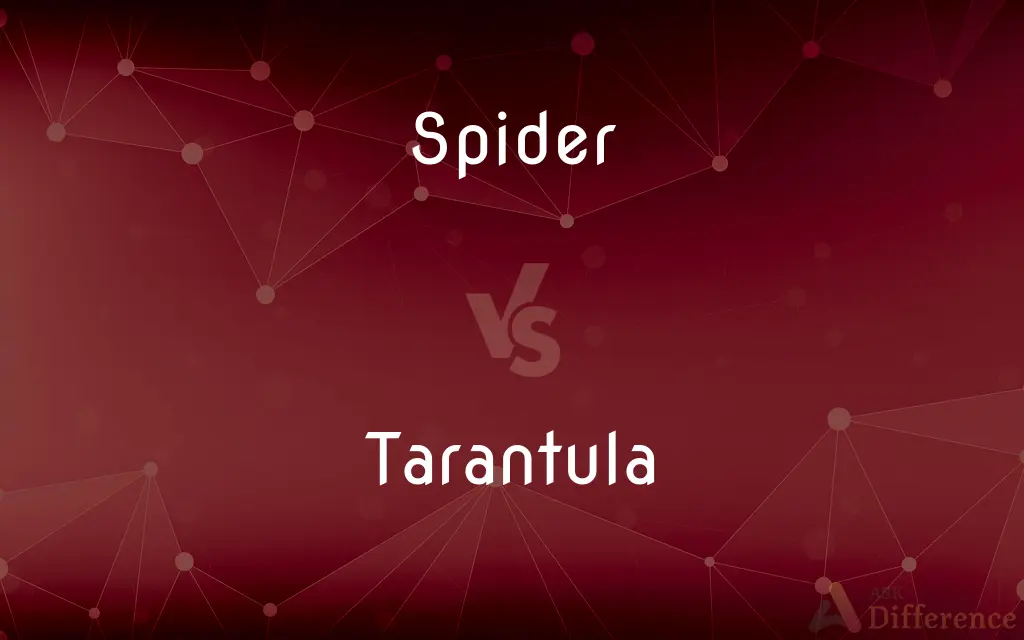Spider vs. Tarantula — What's the Difference?
By Fiza Rafique & Urooj Arif — Updated on March 29, 2024
Spiders are a broad group of arachnids with diverse sizes and habitats, while tarantulas are a specific type of large, hairy spider known for their size and docile nature.

Difference Between Spider and Tarantula
Table of Contents
ADVERTISEMENT
Key Differences
Spiders encompass a wide variety of arachnids found worldwide, characterized by their eight legs, ability to produce silk, and diverse living environments. Tarantulas, on the other hand, represent a specific subset of spiders known for their large size, thick, hairy bodies, and relatively long lifespans. They are often kept as pets due to their docile nature.
While most spiders are small and have a lifespan of about 1-2 years, tarantulas can live for several decades, especially females. This longevity, combined with their size, makes tarantulas particularly notable among spider species. Tarantulas also tend to have more specific habitat requirements, often residing in tropical, subtropical, or desert regions, whereas spiders can thrive in a wider range of environments, including indoors.
Spiders generally use their silk to create webs for catching prey, employing various strategies such as trapping or ambushing. Tarantulas, however, do not typically use silk to catch prey; instead, they are hunters that rely on their size and strength to overpower victims. Some tarantulas do use silk to line their burrows or to create shelters in the wild.
Another key difference is in their defensive mechanisms. Many spiders rely on their webs, speed, and sometimes venom to deter predators. Tarantulas, while they do possess venom, are more likely to use their size and hair (urticating hairs, which they can release to irritate potential threats) as their primary means of defense.
The public perception of spiders and tarantulas varies significantly. Spiders often evoke fear due to common phobias and their presence in human homes. Tarantulas, despite their intimidating appearance, are frequently sought after by exotic pet enthusiasts who appreciate their unique characteristics and behavior.
ADVERTISEMENT
Comparison Chart
Size
Ranges from very small to moderately large
Generally large
Lifespan
Typically 1-2 years
Can live up to 20 years or more
Habitat
Diverse, worldwide
Tropical, subtropical, desert regions
Web Usage
Primarily for catching prey
Not typically for catching prey
Hunting Strategy
Various, including trapping and ambushing
Hunting, overpowering prey
Defense Mechanism
Webs, speed, venom
Size, venom, urticating hairs
Public Perception
Often feared, associated with phobias
Feared but also popular as exotic pets
Compare with Definitions
Spider
A small to moderately large arachnid that produces silk.
The garden spider spins intricate webs to trap its prey.
Tarantula
Lives in burrows and does not spin webs to catch prey.
Tarantulas hunt their prey at night, using stealth and strength.
Spider
Known for their eight legs and ability to produce venom.
Many spiders use venom to immobilize their prey.
Tarantula
Popular as exotic pets due to their docile nature.
Many enthusiasts keep tarantulas for their fascinating behaviors.
Spider
Often misunderstood and feared.
Despite common fears, most spiders are harmless to humans.
Tarantula
A type of large, hairy spider known for its size.
The Goliath birdeater is one of the largest tarantulas.
Spider
Found in a wide range of habitats.
Spiders can inhabit forests, deserts, and even human homes.
Tarantula
Possesses urticating hairs as a defense mechanism.
Tarantulas can release hairs that irritate predators' skin and eyes.
Spider
Many species are expert web builders.
Orb-weaver spiders create wheel-shaped webs for catching insects.
Tarantula
Found in warmer climates.
Tarantulas are common in South America's tropical rainforests.
Spider
Spiders (order Araneae) are air-breathing arthropods that have eight legs, chelicerae with fangs generally able to inject venom, and spinnerets that extrude silk. They are the largest order of arachnids and rank seventh in total species diversity among all orders of organisms.
Tarantula
Tarantulas comprise a group of large and often hairy spiders of the family Theraphosidae (technically, spiders possess setae, not true hairs.) Currently, 1,010 species have been identified. The term tarantula is usually used to describe members of the family Theraphosidae, although many other members of the same infraorder (Mygalomorphae) are commonly referred to as "tarantulas" or "false tarantulas".
Spider
An eight-legged predatory arachnid with an unsegmented body consisting of a fused head and thorax and a rounded abdomen. Spiders have fangs which inject poison into their prey, and most kinds spin webs in which to capture insects.
Tarantula
A very large hairy spider found chiefly in tropical and subtropical America, some kinds of which are able to catch small lizards, frogs, and birds.
Spider
An object resembling a spider, especially one having numerous or prominent legs or radiating spokes.
Tarantula
A large black wolf spider of southern Europe, whose bite was formerly believed to cause tarantism.
Spider
Another term for crawler (sense 2)
Tarantula
Any of various large hairy spiders chiefly of the family Theraphosidae, capable of inflicting a bite that is painful but usually not dangerous to humans.
Spider
Move in a scuttling manner suggestive of a spider
A treecreeper spidered head first down the tree trunk
Tarantula
A large wolf spider (Lycosa tarentula) of southern Europe, once thought to cause tarantism.
Spider
Another term for crawl (sense 4 of the verb)
When the search engines spider your site they'll find all of the pages
Tarantula
Any of the large, hairy New World spiders comprising the family Theraphosidae.
Spider
Any of numerous arachnids of the order Araneae, having a body divided into a cephalothorax and an abdomen, eight legs, two chelicerae that bear venom glands, and two or more spinnerets that produce the silk used to make nests, cocoons, or webs for trapping insects.
Tarantula
(by extension) A member of certain other groups of spiders, generally characterized by large size, hairiness, or membership of infraorder Mygalomorphae to which Theraphosidae family also belongs.
Spider
One that resembles a spider, as in appearance, character, or movement.
Tarantula
(dated) A species of wolf spider, Lycosa tarantula, native to southern Europe, the mildly poisonous bite of which was once thought to cause an extreme urge to dance (tarantism).
Spider
A program that automatically retrieves webpages and follows the links on them to retrieve more webpages. Spiders are used by search engines to retrieve publicly accessible webpages for indexing, and they can also be used to check for links to webpages that no longer exist. Also called crawler, search bot.
Tarantula
Any one of several species of large spiders, popularly supposed to be very venomous, especially the European species (Tarantula apuliæ). The tarantulas of Texas and adjacent countries are large species of Mygale.
Spider
New England, Upper Northern, & South Atlantic US See frying pan.
Tarantula
Large southern European spider once thought to be the cause of tarantism (uncontrollable bodily movement)
Spider
A trivet.
Tarantula
Large hairy tropical spider that can inflict painful but not highly venomous bites
Spider
Any of various eight-legged, predatory arthropods, of the order Araneae, most of which spin webs to catch prey.
Spider
A program which follows links on the World Wide Web in order to gather information.
Spider
A float drink made by mixing ice-cream and a soda or fizzy drink (such as lemonade).
Spider
An alcoholic drink made with brandy and lemonade or ginger beer.
Spider
(slang) A spindly person.
Spider
(slang) A man who persistently approaches or accosts a woman in a public social setting, particularly in a bar.
Spider
A stick with a convex arch-shaped notched head used to support the cue when the cue ball is out of reach at normal extension; a bridge.
Spider
A cast-iron frying pan with three legs, once common in open-hearth cookery.
Spider
(cooking) Implement for moving food in and out of hot oil for deep frying, with a circular metal mesh attached to a long handle; a spider skimmer
Spider
(cycling) A part of a crank, to which the chainrings are attached.
Spider
Heroin.
Spider
(music) Part of a resonator instrument that transmits string vibrations from the bridge to a resonator cone at multiple points.
Spider
A skeleton or frame with radiating arms or members, often connected by crosspieces, such as a casting forming the hub and spokes to which the rim of a fly wheel or large gear is bolted; the body of a piston head; or a frame for strengthening a core or mould for a casting.
Spider
A soft-hackle fly.
Spider
(sports) The network of wires separating the areas of a dartboard.
Spider
(maths) A spider graph or spider tree.
Spider
(obsolete) A type of light phaeton.
Spider
(photography) A support for a camera tripod, preventing it from sliding.
Spider
(lawn bowls) A competition in which several participants are spread evenly around the edges of the green, who all make one bowl towards the central jack at the same time; the winner being the person whose bowl ends up closest to the jack.
Spider
To move like a spider.
Spider
To cover a surface like a cobweb.
Spider
To follow links on the World Wide Web in order to gather information.
The online dictionary is regularly spidered by search engines.
Spider
Any one of numerous species of arachnids comprising the order Araneina. Spiders have the mandibles converted into poison fangs, or falcers. The abdomen is large and not segmented, with two or three pairs of spinnerets near the end, by means of which they spin threads of silk to form cocoons, or nests, to protect their eggs and young. Many species spin also complex webs to entrap the insects upon which they prey. The eyes are usually eight in number (rarely six), and are situated on the back of the cephalothorax. See Illust. under Araneina.
Spider
Any one of various other arachnids resembling the true spiders, especially certain mites, as the red spider (see under Red).
Spider
An iron pan with a long handle, used as a kitchen utensil in frying food. Originally, it had long legs, and was used over coals on the hearth.
Spider
A trevet to support pans or pots over a fire.
Spider
A skeleton, or frame, having radiating arms or members, often connected by crosspieces; as, a casting forming the hub and spokes to which the rim of a fly wheel or large gear is bolted; the body of a piston head; a frame for strengthening a core or mold for a casting, etc.
Spider
Predatory arachnid that usually has silk-spinning organs at the back end of the body; they spin silk to make cocoons for eggs or traps for prey
Spider
A computer program that prowls the internet looking for publicly accessible resources that can be added to a database; the database can then be searched with a search engine
Spider
A skillet made of cast iron
Common Curiosities
Can tarantulas be kept as pets?
Yes, tarantulas are popular as pets for those interested in exotic animals due to their unique appearance and behavior.
Can all spiders produce silk?
Yes, all spiders have silk-producing glands, but they use silk in various ways, including web-building, creating shelters, or laying egg sacs.
What is the main difference between a spider and a tarantula?
The main difference is that tarantulas are a specific group of large, hairy spiders, while the term "spider" refers to a broader category of arachnids.
How do spiders and tarantulas catch their prey?
Spiders often use webs to catch prey, while tarantulas rely on hunting and overpowering their prey directly.
What are urticating hairs?
Urticating hairs are special hairs that some tarantulas have, which they can release to irritate the skin and eyes of predators.
Why do people fear spiders and tarantulas?
Many people fear spiders and tarantulas due to their appearance, the way they move, and common phobias, although most are harmless.
Do all spiders have venom?
Nearly all spiders are venomous to some extent, but most are harmless to humans.
Are tarantulas dangerous to humans?
Most tarantulas have venom that is harmless to humans, similar to a bee sting in terms of pain and effect.
How do tarantulas reproduce?
Tarantulas reproduce through a mating ritual, after which the female lays eggs in a silk cocoon.
Can spiders live in every environment?
Spiders are adaptable and can be found in nearly every terrestrial habitat, from deserts to forests and even human dwellings.
What habitats do tarantulas prefer?
Tarantulas typically prefer warm climates such as tropical, subtropical, and desert regions.
Are spiders beneficial to humans?
Yes, spiders are beneficial as they control insect populations, reducing pests in homes and gardens.
What is the diet of a tarantula?
Tarantulas primarily eat insects, but larger species may also consume small mammals and reptiles.
How long can tarantulas live?
Tarantulas can live for several decades, with females often living longer than males.
Why do tarantulas not use webs to catch prey?
Tarantulas do not use webs for hunting because they are ground-dwelling hunters that use stealth and strength to capture prey.
Share Your Discovery

Previous Comparison
Otc vs. Exchange
Next Comparison
Dehumidifier vs. HumidifierAuthor Spotlight
Written by
Fiza RafiqueFiza Rafique is a skilled content writer at AskDifference.com, where she meticulously refines and enhances written pieces. Drawing from her vast editorial expertise, Fiza ensures clarity, accuracy, and precision in every article. Passionate about language, she continually seeks to elevate the quality of content for readers worldwide.
Co-written by
Urooj ArifUrooj is a skilled content writer at Ask Difference, known for her exceptional ability to simplify complex topics into engaging and informative content. With a passion for research and a flair for clear, concise writing, she consistently delivers articles that resonate with our diverse audience.














































